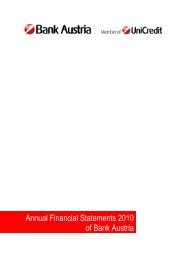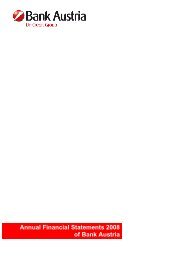Annual Financial Statements 2011 of Bank Austria
Annual Financial Statements 2011 of Bank Austria
Annual Financial Statements 2011 of Bank Austria
You also want an ePaper? Increase the reach of your titles
YUMPU automatically turns print PDFs into web optimized ePapers that Google loves.
Consolidated <strong>Financial</strong> <strong>Statements</strong> in accordance with IFRSs<br />
A – Accounting policies (CoNTINuED)<br />
Available-for-sale financial assets (AfS)<br />
Available-for-sale financial instruments include debt instruments and equity instruments. Equity instruments classified as available for sale are<br />
those which are not classified as held for trading or at fair value through pr<strong>of</strong>it or loss. To determine their fair values, the methods described in<br />
“Fair values – fair value hierarchy” below are used. Changes in fair values resulting from remeasurement are recognised in a component <strong>of</strong> equity<br />
(available-for-sale reserve) with no effect on income until the disposal <strong>of</strong> the financial asset. Impairment losses are recognised in income. Reversals<br />
<strong>of</strong> impairment losses on equity instruments are recognised in the available-for-sale reserve within equity; reversals <strong>of</strong> impairment losses on<br />
debt instruments are recognised in pr<strong>of</strong>it or loss.<br />
Shares in companies which are neither consolidated nor accounted for under the equity method are classified as available for sale.<br />
Held-to-maturity investments (HtM)<br />
Non-derivative financial assets with fixed or determinable payments and fixed maturity are classified as held-to-maturity investments if the Group<br />
has the positive intention and ability to hold them to maturity.<br />
If, during the financial year, more than an insignificant amount <strong>of</strong> held-to-maturity investments are sold or reclassified before maturity, the<br />
remaining HtM financial assets shall be reclassified as available-for-sale and no financial assets shall be classified as HtM investments for the<br />
two following financial years, unless the sales or reclassifications:<br />
• are so close to maturity or the financial asset’s call date that changes in the market rate <strong>of</strong> interest would not have a significant effect on the<br />
financial asset’s fair value;<br />
• occur after substantially all <strong>of</strong> the financial asset’s original principal has been collected through scheduled payments or prepayments;<br />
• are attributable to an isolated event that is beyond the reporting entity’s control, is non-recurring and could not have been reasonably anticipated.<br />
After initial recognition, held-to-maturity investments are recognised at amortised cost using the effective interest method, with any reduction for<br />
impairment. Impairment losses within the meaning <strong>of</strong> IAS 39.63 are recognised in pr<strong>of</strong>it or loss in the item Impairment losses on held-to-maturity<br />
investments.<br />
Loans and receivables<br />
Loans and receivables are non-derivative financial assets with fixed or determinable payments that are not quoted in an active market. After initial<br />
recognition such financial assets are measured at amortised cost using the effective interest method, with any reduction for impairment. The<br />
computation <strong>of</strong> amortised cost includes a premium or discount upon acquisition, and fees or costs constituting an integral part <strong>of</strong> the effective<br />
interest rate. Income from amortisation using the effective interest method is included in the income statement as part <strong>of</strong> financial income.<br />
Impairment losses are recognised in the income statement as financial expenses.<br />
Fair values – fair value hierarchy<br />
In accordance with IFRS 7, financial instruments measured at fair value and stated at their fair values in the statement <strong>of</strong> financial position are<br />
classified according to a three-level fair value hierarchy based on the significance and liquidity <strong>of</strong> input parameters used for valuation purposes:<br />
• Level 1 – Quoted prices (without adjustment) in active markets for identical assets or liabilities<br />
• Level 2 – Observable inputs not qualifying as quoted prices according to Level 1<br />
• Level 3 – Non-observable inputs<br />
<strong>Financial</strong> instruments whose fair value is determined by using a valuation method are included in their entirety in Level 2 or Level 3, on the basis<br />
<strong>of</strong> the lowest level <strong>of</strong> the parameters which are significant for fair value.<br />
Level 1 contains financial instruments for which prices for identical assets or liabilities are directly observable in active markets and may be used<br />
for valuation without adjustment. This category includes in particular listed securities and derivatives if they are traded on an active market.<br />
Over-the-counter (OTC) derivatives cannot be included in Level 1 because these are specific contracts between counterparties for which there is<br />
no active market for “identical” instruments.<br />
Level 2 shows assets or liabilities whose fair value is determined on the basis <strong>of</strong> a valuation model. This does not involve the use <strong>of</strong> any non-observable<br />
inputs which are significant for valuation. Level 2 also includes instruments whose fair value is determined on the basis <strong>of</strong> a quoted price<br />
for an identical instrument for which there is no active market.<br />
<strong>Bank</strong> <strong>Austria</strong> · <strong>Annual</strong> <strong>Financial</strong> <strong>Statements</strong> <strong>2011</strong><br />
75
















